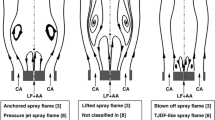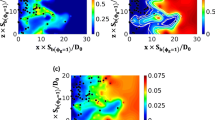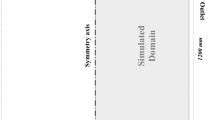Abstract
Numerical simulations of turbulent flame kernel growths in monodisperse clouds of iso-octane liquid droplets are conducted in conditions relevant to constant volume combustors. The simulations make use of a low-Mach number Navier-Stokes solver and a thermodynamic pressure evolution model has been implemented to reproduce the pressure variation that may be issued from either experiments or from a standard (i.e., analytical) compression law. Chemistry is described with a representative skeletal mechanism featuring 29 species and 48 elementary reaction steps. The computational results clearly confirm the enhancement of flame propagation in constant volume combustion conditions. The impact of the droplet diameter on the turbulent flame development is scrutinized for two distinct values of the Stokes number St equal to 0.1 and 1.0. Significant influence on the flame dynamics is put into evidence. This is a direct outcome of the equivalence ratio and temperature heterogeneities, which are themselves very sensitive to the choice of the Stokes number value. Then, small-scale turbulence-scalar interactions (TSI) are studied by analyzing the fields of the scalar gradients and strain-rate. Their dynamics is investigated for both non-reactive and reactive two-phase flows conditions. The TSI analysis is performed on the basis of time evolution equations written for quantities that characterize the couplings between the velocity gradient tensor and scalar gradients vectors. Special emphasis is placed on the possible influence of mass exchange terms between the liquid and gaseous phases.




















Similar content being viewed by others
Notes
The droplet diameter is approximately 6.1 μ m for cases associated to St = 1.0. It is approximately 1.9 μ m for those corresponding to St = 0.1, the values of the kinetic and evaporation relaxation times are thus significantly smaller (i.e., 10 times smaller) than those associated with simulations conducted at St = 1.0
The retained definition of the premixedness index is provided in Appendix B.
Once normalized by its value at stoichiometry, i.e., yCO, st, the carbon atom to oxygen atom mass fractions ratio, i.e., yCO/yCO, st, can be thought as the equivalence ratio.
The transport term TR is sufficiently small to be discarded from the present analysis.
One may however expect that the corresponding correlation is decreased for sufficiently large values of the velocity fluctuations RMS normalized by the laminar flame velocity \({S_{L}^{0}}\).
References
Labarrere, L., Poinsot, T., Dauptain, A., Duchaine, F., Bellenoue, M., Boust, B.: Experimental and numerical study of cyclic variations in a constant volume combustion chamber. Combust. Flame 172, 49 (2016)
Bhagatwala, A., Chen, J.H., Lu, T.: Direct numerical simulations of HCCI/SACI with ethanol. Combust. Flame 161(7), 1826 (2014)
Bhagatwala, A., Sankaran, R., Kokjohn, S., Chen, J.H.: Numerical investigation of spontaneous flame propagation under RCCI conditions. Combust. Flame 162(9), 3412 (2014)
Zhang, F., Yu, R., Bai, X.S.: Effect of split fuel injection on heat release and pollutant emissions in partially premixed combustion of PRF70/air/EGR mixtures. Appl. Energy 149, 283 (2015)
Wang, L., Maxey, M.R.: Settling velocity and concentration distribution of heavy particles in homogeneous isotropic turbulence. J. Fluid Mech. 256, 27 (1993)
Jenny, P., Roekaerts, D., Beishuizen, N.: Modeling of turbulent dilute spray combustion. Prog. Energy Combust. Sci. 38(6), 846 (2012)
Reveillon, J., Demoulin, F.: Effects of the preferential segregation of droplets on evaporation and turbulent mixing. J. Fluid Mech. 583, 273 (2007)
Reveillon, J., Demoulin, F.: Evaporating droplets in turbulent reacting flows. Proc. Combust. Inst. 31(2), 2319 (2007)
Kah, D., Laurent, F., Fréret, L., de Chaisemartin, S., Reveillon, J., Massot, M.: Eulerian quadrature-based moment models for dilute polydisperse evaporating sprays. Flow Turbul. Combust. 85, 649 (2010)
Bouali, Z., Pera, C., Reveillon, J.: Numerical analysis of the influence of two-phase flow mass and heat transfer on n-heptane autoignition. Combust. Flame 159 (6), 2056 (2012)
Dombard, J., Leveugle, B., Selle, L., Reveillon, J., Poinsot, T., D’Angelo, Y.: Modeling heat transfer in dilute two-phase flows using the mesoscopic Eulerian formalism. Int. J. Heat and Mass Transfer 55(5), 1486 (2012)
Bouali, Z., Duret, B., Demoulin, F.X., Mura, A.: DNS analysis of small-scale turbulence-scalar interactions in evaporating two-phase flows. Int. J. Multiphase Flow 85, 326 (2016)
Wacks, D.H., Chakraborty, N., Mastorakos, E.: Statistical analysis of turbulent flame-droplet interaction: a direct numerical simulation study. Flow Turbul. Combust. 96(2), 573 (2016)
Wacks, D.H., Chakraborty, N.: Flame structure and propagation in turbulent flame-droplet interaction: a direct numerical simulation analysis. Flow Turbul. Combust. 96(4), 1053 (2016)
Pope, S.: PDF methods for turbulent reactive flows. Prog. Energy Combust. Sci. 11(2), 119 (1985)
Borghi, R.: Turbulent combustion modelling. Prog. Energy Combust. Sci. 14(4), 245 (1988)
Dopazo, C.: Recent Developments in PDF Methods, pp 375–474. Academic Press Limited, London (1994)
Mura, A., Robin, V., Champion, M.: Modeling of scalar dissipation in partially premixed turbulent flames. Combust. Flame 149(1-2), 217 (2007)
Mura, A., Borghi, R.: Towards an extended scalar dissipation equation for turbulent premixed combustion. Combust. Flame 133(1), 193 (2003)
Bilger, R.W.: Some aspects of scalar dissipation. Flow Turbul. Combust. 72(2), 93 (2004)
Xia, J., Luo, K.H.: Direct numerical simulation of diluted combustion by evaporating droplets. Proc. Combust. Inst. 32(2), 2267 (2009)
Beishuizen, N.: PDF modelling and particle-turbulence interaction of turbulent spray flames. Ph.D. thesis, TU Delft (2008)
Xia, J., Luo, K.H.: Direct numerical simulation of inert droplet effects on scalar dissipation rate in turbulent reacting and non-reacting shear layers. Flow Turbul. Combust. 84(3), 397 (2010)
Gomet, L., Robin, V., Mura, A.: Lagrangian modelling of turbulent spray combustion under liquid rocket engine conditions. Acta Astronaut. 94(1), 184 (2014)
Hu, Y., Olguin, H., Gutheil, E.: Transported joint probability density function simulation of turbulent spray flames combined with a spray flamelet model using a transported scalar dissipation rate. Combust. Sci. Technol. 189(2), 322 (2017)
Zhao, P., Wang, L., Chakraborty, N.: Strain rate and flame orientation statistics in the near-wall region for turbulent flame-wall interaction. Combust. Theor. Model. 22(5), 921 (2018)
Mura, A., Tsuboi, K., Hasegawa, T.: Modelling of the correlation between velocity and reactive scalar gradients in turbulent premixed flames based on DNS data. Combust. Theor. Model. 12(4), 671 (2008)
Chakraborty, N., Champion, M., Mura, A., Swaminathan, N.: Scalar dissipation rate approach. Turbulent Premixed Flames pp. 74–102 (2011)
Chakraborty, N., Swaminathan, N.: Influence of the Damköhler number on turbulence-scalar interaction in premixed flames. II. Model development. Phys. Fluids 19(4), 045104 (2007)
Nomura, K.K., Post, G.K.: The structure and dynamics of vorticity and rate of strain in incompressible homogeneous turbulence. J. Fluid Mech. 377, 65 (1998)
Diamessis, P., Nomura, K.K.: Interaction of vorticity, rate-of-strain, and scalar gradient in stratified homogeneous sheared turbulence. Phys. Fluids 12(5), 1166 (2000)
Tsinober, A.: An Informal Conceptual Introduction to Turbulence, vol. 483. Springer, Berlin (2009)
Zhao, S., Er-raiy, A., Bouali, Z., Mura, A.: Dynamics and kinematics of the reactive scalar gradient in weakly turbulent premixed flames. Combust. Flame 198, 436 (2018)
Reveillon, J., Péra, C., Bouali, Z.: Examples of the potential of DNS for the understanding of reactive multiphase flows. Int. J. Spray Combust. Dyn. 3, 63 (2011)
Chauvy, M., Delhom, B., Reveillon, J., Demoulin, F.X.: Flame/wall interactions: laminar study of unburnt HC formation. Flow Turbul. Combust. 84, 369 (2010)
Er-Raiy, A., Bouali, Z., Reveillon, J., Mura, A.: Optimized single-step (OSS) chemistry models for the simulation of turbulent premixed flame propagation. Combust. Flame 192, 130 (2018)
Falgout, R.D., Yang, U.M.: HYPRE: a Library of High Performance Preconditioners, pp 632–641. Springer, Heidelberg (2002)
Hindmarsh, A.C., Brown, P.N., Grant, K.E., Lee, S.L., Shumaker, D.E., Woodward, C.S.: SUNDIALS: suite of nonlinear and differential/algebraic equation solvers. ACM Trans. Math. Soft. 31, 363 (2005)
Crowe, C., Sharma, M., Stock, D.: The particle-source-in cell (PSI-CELL) model for gas-droplet flows. J. Fluids Eng. 99(2), 325 (1977)
Hasse, C., Bollig, M., Peters, N., Dwyer, A.H.: Quenching of laminar iso-octane flames at cold walls. Combust. Flame 122(1), 117 (2000)
Rogallo, R.S.: Numerical experiments in homogeneous turbulence. Tech. Rep. NASA TM 81315, NASA Ames Res. Center (1981)
Passot, T., Pouquet, A.: Numerical simulation of compressible homogeneous flows in the turbulent regime. J. Fluid Mech. 181, 441 (1987)
Bassenne, M., Urzay, J., Park, G.I., Moin, P.: Constant-energetics physical-space forcing methods for improved convergence to homogeneous-isotropic turbulence with application to particle-laden flows. Phys. Fluids 28(3) (2016)
Kerstein, A.R., Law, C.K.: Percolation in combusting sprays I: Transition from cluster combustion to percolate combustion in non-premixed sprays. Symp. Combust. 19(1), 961 (1982)
Borghi, R., Loison, S.: Studies of dense-spray combustion by numerical simulation with a cellular automaton. Symp. Combust. 24, 1541 (1992)
Borghi, R., Champion, M.: Modelisatioń et théorie des flammes (Editions Technip) (2000)
Ahmed, U., Turquand d’Auzay, C., Muto, M., Chakraborty, N., Kurose, R.: Statistics of reaction progress variable and mixture fraction gradients of a pulverised coal jet flame using direct numerical simulation data. Proc. Combust. Inst. 37, 2821 (2019)
Lipatnikov, A.N., Chomiak, J.: Effects of premixed flames on turbulence and turbulent scalar transport. Prog. Energy Combust. Sci. 36, 1 (2010)
Sabelnikov, V.A., Lipatnikov, A.N.: Recent advances in understanding of thermal expansion effects in premixed turbulent flames. Ann. Rev. Fluid Mech. 49, 91 (2017)
Hamlington, P.E., Poludnenko, A.Y., Oran, E.S.: Interactions between turbulence and flames in premixed reacting flows. Phys. Fluids 23(12) (2011)
Hartung, G., Hult, J., Kaminski, C.F., Rogerson, J.W., Swaminathan, N.: Effect of heat release on turbulence and scalar-turbulence interaction in premixed combustion. Phys. Fluids 20, 035110 (2008)
Steinberg, A.M., Driscoll, J.F., Swaminathan, N.: Statistics and dynamics of turbulence-flame alignment in premixed combustion. Combust. Flame 159(8), 2576 (2012)
Gonzalez, M., Paranthoën, P.: Effect of density step on stirring properties of a strain flow. Fluid Dyn. Res. 41, 035508 (2009)
Gonzalez, M., Paranthoën, P.: Effects of variable mass density on the kinematics of scalar gradient. Phys. Fluids 23, 075107 (2011)
Steinberg, A.M., Coriton, B., Frank, J.H.: Influence of combustion on principal strain-rate transport in turbulent premixed flames. Proc. Combust. Inst. 35, 1287 (2015)
Brethouwer, G., Hunt, J.C.R., Nieuwstadt, F.T.M: Micro structure and Lagrangian statistics of the scalar field with a mean gradient in isotropic turbulence. J. Fluid Mech. 70, 33 (2002)
Garcia, A., Gonzalez, M.: Analysis of passive scalar gradient alignment in a simplified three-dimensional case. Phys. Fluids 18(5), 058101 (2006)
Chakraborty, N., Klein, M., Swaminathan, N.: Effects of Lewis number on the reactive scalar gradient alignment with local strain rate in turbulent premixed flames. Proc. Combust. Inst. 32, 1409 (2009)
Bray, K., Domingo, P., Vervisch, L.: Role of the progress variable in models for partially premixed turbulent combustion. Combust. Flame 141(4), 431 (2005)
Robin, V., Mura, A., Champion, M., Degardin, O., Renou, B., Boukhalfa, M.: Experimental and numerical analysis of stratified turbulent V-shaped flames. Combust. Flame 153(1), 288 (2008)
Robin, V., Mura, A., Champion, M., Plion, P.: Modélisation de la combustion turbulente des mélanges hétérogènes en richesse : Des flammes de prémélange aux flammes de diffusion. Comptes Rendus Mécanique 337(8), 596 (2009)
Robin, V., Guilbert, N., Mura, A., Champion, M.: Modélisation de la combustion turbulente des mélanges hétérogènes en richesse. Application au calcul d’une flamme stabilisée par l’élargissement brusque d’un canal bidimensionnel. Comptes Rendus Mécanique 338(1), 40 (2010)
Malkeson, S.P., Chakraborty, N.: Statistical analysis of cross scalar dissipation rate transport in turbulent partially premixed flames: a direct numerical simulation study. Flow Turbul. Combust. 87, 313 (2011)
Pires Da Cruz, A., Dean, A., Grenda, J.: A numerical study of the laminar flame speed of stratified methane/air flames. Proc. Combust. Inst. 28, 1925 (2000)
Renou, B., Samson, E., Boukhalfa, A.: An experimental study of freely propagating turbulent propane/air flames in stratified inhomogeneous mixtures. Combust. Sci. Technol. 176, 1867 (2004)
Buttay, R., Gomet, L., Lehnasch, G., Mura, A.: Highly resolved numerical simulation of combustion downstream of a rocket engine igniter. Shock Waves 27(4), 655 (2017)
Yamashita, H., Shimada, M., Takeno, T.: A numerical study on flame stability at the transition point of jet diffusion flames. Symp. Combust. 26(1), 27 (1996)
Acknowledgments
This work is funded by the CAPA Program (CNRS, ENSMA, SAFRAN, and MBDA) of the ANR (Agence Nationale de la Recherche). A part of this work has been performed using high-performance computing (HPC) resources from GENCI (Grand Equipement National de Calcul Intensif)-[CCRT/CINES/IDRIS] under Grant A0052B07456.
Funding
As stated in the acknowledgements section, this work has been funded by the CAPA Program (CNRS, ENSMA, SAFRAN, and MBDA) of the ANR (Agence Nationale de la Recherche).
Author information
Authors and Affiliations
Corresponding author
Ethics declarations
Conflict of interests
The authors declare that they have no conflict of interest.
Additional information
Publisher’s Note
Springer Nature remains neutral with regard to jurisdictional claims in published maps and institutional affiliations.
Appendices
Appendix A: Thermodynamic Pressure Variation with Artificial Mass Sources and Chemical Heat Release
The thermodynamic pressure evolution is deduced from the analysis of the normalized EoS together with a non-dimensional form of the NSE featuring an artificial mass source term \(\dot {m}_{p}\), see Eq. 2d in Section 2. Since Asphodele resolves the non-dimensional form of NSE, the thermodynamic pressure evolution is considered within the corresponding non-dimensional framework:
In the above equations, variables with superscript (+) are normalized quantities, and the subscript (ref) and \((_{\infty })\) denote either normalization (reference) parameters or values of physical quantities taken at infinity. The quantities that are reported at the end of each line (in brackets) correspond to values that are used to normalize the corresponding equations. A standard normalization procedure for low-Mach conditions is retained:
and the normalized EoS can be written as follows
On the one hand, the derivative analysis of Eq. 28b gives
where
On the other hand, the derivative of the sensible enthalpy definition (i.e., Eq. 28b) reads
Using Eq. 30 and considering \({r^{+}}/{C_{p}^{+}}={(\gamma -1)}/{\gamma }\), Eq. 29 becomes
from which one may obtain
where \({dh_{s}^{+}}/{dt^{+}}\) must be further expanded using the energy conservation (26d), because it includes a pressure derivative in its RHS. Then, we define \(\rho ^{+} {d\hbar _{s}^{+}}/{dt^{+}} \equiv \dot {\omega }_{T}^{+}-{\partial q^{+}_{j}}/{\partial x_{j}^{+}}+ \text {Ma}_{\infty }^{2}\left (\gamma _{\infty }-1 \right )\tau _{ij}^{+} {\partial u^{+}_{i}}/{\partial x_{j}^{+}} +\dot {d}_{\rho h_{s}}^{+}-\dot {d}_{\rho }^{+} h_{s}^{+}\), where it is noteworthy that the second term, which is associated to the dissipation function, can be neglected within the low Mach number framework.
The governing equation of pressure can be expressed as
For the sake of simplicity, the super/subscript for normalized (+) and leading order (0) are no longer considered in the above expression. It is worth noting that, this equation is valid everywhere in the calculation domain. However, due to the spatial uniformity of the thermodynamic pressure, an averaged form of this equation over a volume \(\mathcal {V}\) is preferred so as to avoid numerical difficulties. Finally, the thermodynamic pressure evolution will be determined from
with \(\rho {d\hbar _{s}} \equiv \dot {\omega }_{T}-{\partial q_{j}}/{\partial x_{j}}+\dot {d}_{\rho h_{s}}-\dot {d}_{\rho } h_{s}\).
Appendix B: Evaluation of the Premixedness Index
The premixedness index is evaluated from the generalized definition introduced in reference [66]:

where  denotes the molecular diffusion velocity of species α. The above expression can also be written as follows: \(\xi _{p} = \left (1+ \boldsymbol {n}_{F} \cdot \boldsymbol {n}_{O} \right )/2\) and, since Fickian diffusion has been assumed, the unit vector nk, which gives the diffusion fluxes direction, may be expressed from the species mass fraction isolines: nα = ∇Yα/|∇Yα|. This allows to relate the premixedness index ξp to the Takeno index GFO = ∇YF ⋅∇YO [67]:
denotes the molecular diffusion velocity of species α. The above expression can also be written as follows: \(\xi _{p} = \left (1+ \boldsymbol {n}_{F} \cdot \boldsymbol {n}_{O} \right )/2\) and, since Fickian diffusion has been assumed, the unit vector nk, which gives the diffusion fluxes direction, may be expressed from the species mass fraction isolines: nα = ∇Yα/|∇Yα|. This allows to relate the premixedness index ξp to the Takeno index GFO = ∇YF ⋅∇YO [67]:
In one-dimensional flame structures described with single-step chemistry, the above index is zero in non-premixed conditions while it is unity in premixed conditions [67]. In contrast to the standard definition of reference [67], which was based on single-step chemistry, YF and YO do not presently correspond to the mass fractions of fuel and oxidizer. The definition has been indeed generalized herein by considering the mass fractions of unburnt carbon and oxygen atoms
Appendix C: Derivation of Transport Equations of Scalar Alignments
For a scalar field ξ(x, t) the transport equation of which can be written as
with D the diffusion coefficient of the scalar and \(\dot {\omega }_{\xi }\) the source term, the transport equation for its gradient g ≡∇ξ can be obtained
where S is the strain tensor, ω is the vorticity and \(\text {RHS}_{\xi } \equiv \boldsymbol {\nabla }\cdot (\rho D \boldsymbol {\nabla } \xi )/\rho + \dot {\omega }_{\xi }\) denotes the right hand side (RHS) of the transport equation of the scalar. Then, the transport equation for its norm direction vector \(\boldsymbol {n}\equiv {\boldsymbol {g}}/{\left | \boldsymbol {g} \right |}\) can be deduced from Eq. 39
where the matrix \(\boldsymbol {\mathcal {I}}\boldsymbol {\mathcal {N}}\) is defined as follows
with I the identity matrix.
The projection of n in the eigenframe of S can be characterized with the vector
with R is the eigenmatrix of S
where ei are the eigenvectors of S corresponding to eigenvalues λi with a descending order, i.e., λ1 > λ2 > λ3. Finally, the transport equation for \(\boldsymbol {\widehat {n}}\) can be achieved
where Λ is the diagonal matrix based on the eigenvalues of S,
Since we have
the last term in Eq. 44 can be expanded as follows
where the anti-symmetric tensor \(\boldsymbol {\mathcal {W}}\) denotes the rate of rotation of the principal axes
In fact, this tensor can be evaluated from the transport equation of the strain-rate tensor in eigenframe (D(RTSR)/Dt), it reads
where δij is the Kronecker delta tensor and the substantial derivative of the velocity is given by
In summary, the transport equation for the projection of n in the eigenframe of the strain-tensor reads:
where the vector TW and GR are defined as
Rights and permissions
About this article
Cite this article
Zhao, S., Bouali, Z. & Mura, A. Computational Investigation of Weakly Turbulent Flame Kernel Growths in Iso-Octane Droplet Clouds in CVC Conditions. Flow Turbulence Combust 104, 139–177 (2020). https://doi.org/10.1007/s10494-019-00051-x
Received:
Accepted:
Published:
Issue Date:
DOI: https://doi.org/10.1007/s10494-019-00051-x




